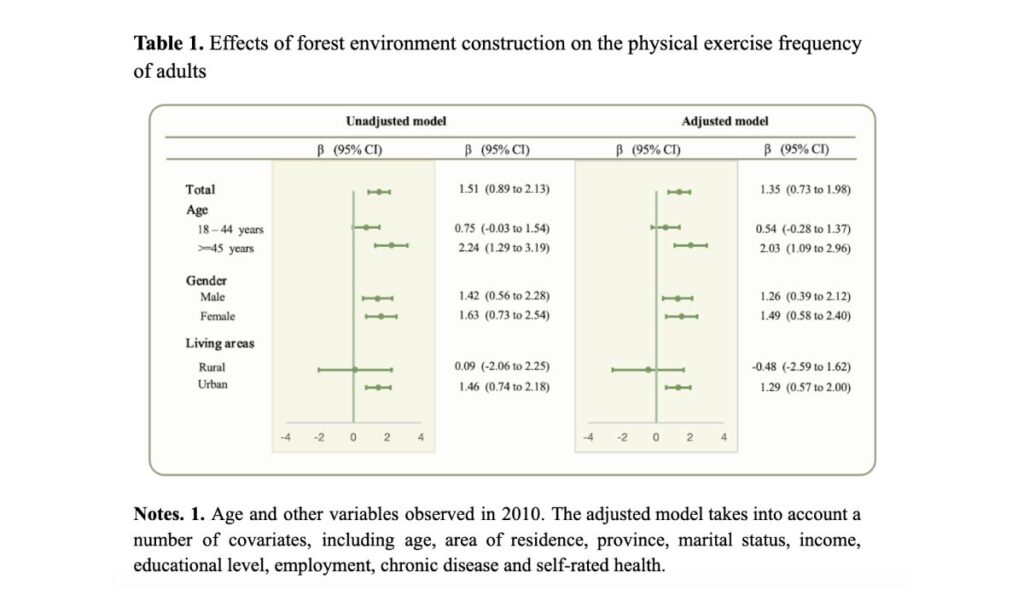Effects of forest environment construction on physical activity

The Chinese government attaches great importance to the construction of National Forest Cities, which have proved effective not only as part of the national low-carbon environmental strategy, but also as a stimulus to physical activity in mainland China. Huameng Tang, Dianqi Yuan and Chao Guo describe their positive impact.
Forests around the world are increasingly affected by factors related to climate change, along with industrialization and lifestyle changes. Among other consequences, this diminishes opportunities for human contact with nature and results in worse health outcomes. With the aim of reducing vulnerability to increasing threats from climate change as well as improving population health and well-being, China has implemented multiple measures since 2004 to improve forest management, including promoting the construction of National Forest Cities.
National Forest Cities in China…
After approval of the national forestry authorities, a city can be awarded the title of National Forest City if both its urban and rural areas meet all the necessary criteria. These include urban forest coverage, greening along water bodies and roads, nature reserves and major forest and wetland ecosystems, as well as residential recreational greenspaces, which must be public and easily accessible (i.e. in close proximity to most citizens, within 500 meters, on average). By the end of 2022, there were 219 National Forest Cities in China in 25 provinces, forming a cross-regional and urban‒rural construction system.
Although intended primarily for environmental improvement, these forest cities also include sites and facilities that encourage physical activities. However, despite the rapid increase in research on environmental features and physical activity behaviors over the last few decades, there is still a lack of reliable empirical evidence on the effect of these forest cities on residents’ physical well-being.
… and their effect on physical activity: a quasi-experimental study
We attempted to fill this knowledge gap in a recent paper (Tang et al 2024), using a difference-in-difference, or DID, model, which, in our case, focused on differences in the frequency of physical activity before and after the construction of the forest cities, comparing regions with different densities of forest cities. The DID model circumvents otherwise difficult-to-treat issues such as time trends and individual characteristics.
Our data come from the nationally representative 2010 China Family Panel Studies (CFPS), and its 2018 follow-up. This is a multistage, stratified cluster sampling representing 95% of the population in mainland China. Among other things, respondents were asked to specify the number of physical activities they had engaged in during the preceding week, which is our variable of interest.
Living in a forest city can be considered exogenous (it does not depend on individual choices), and we measured exposure to this exogenous intervention in terms of both degree (number of forest cities by area at the provincial level) and duration (time elapsed since the City was awarded the title of National Forest). This proved possible because respondents were interviewed in areas with different degrees of forest environment construction, as measured by the number of forest cities, and different construction timelines. During the survey windows (i.e. between 2010 and 2018), 11 provinces established 1-3 forest cities, 13 provinces established more than three, and the remaining six provinces did not establish any.
Results
The DID estimates revealed that forest environment construction significantly promotes residents’ physical activities. After the construction of forest cities, the number of physical activities per week increased by 1.35 units (β = 1.35, 95% CI: 0.73–1.98) compared to provinces without forest cities (Table 1). An increase of 1.35 may seem small, but first, it is statistically significant, even after adjusting for covariates such as age, area of residence, province, marital status, income, educational level, employment, chronic disease and self-rated health, and second, it represents a considerable step forward given the relatively low initial levels.

Perhaps not surprisingly, there were notable disparities across age groups and areas of residence. The positive effect of forest environment construction on physical activity was particularly strong among middle-aged and older adults (aged 45 and above), and people living in urban areas.
Among younger adults aged (up to 44 years of age), the frequency of physical activity also increased after forest environment construction, but the difference was not statistically significant.
Behavioral changes facilitated by environmental construction
To the best of our knowledge, this study is the first to provide insights on the impact of forest environment construction on physical activity among Chinese residents. The main finding is that the construction of a forest environment promotes physical activity, especially among middle-aged and older adults, and people living in urban areas.
Although urbanization and land use change are irrevocably altering the environment in which many residents live, forest-environment construction has succeeded in reducing the distance between people and the natural environment and plays a role in improving population fitness. However, considering the heterogeneity of these effects, more should be done to make sure that everybody benefits from the construction of forest cities, for instance in terms advertising their existence and promoting their potential for “green exercise”.
References
Tang, H. M., Yuan, D. Q., Yang, P. S., Yang, H. B., & Guo, C. (2024) The effect of forest-environment construction on the physical activity among Chinese adults. Environmental Research Letters, 19.